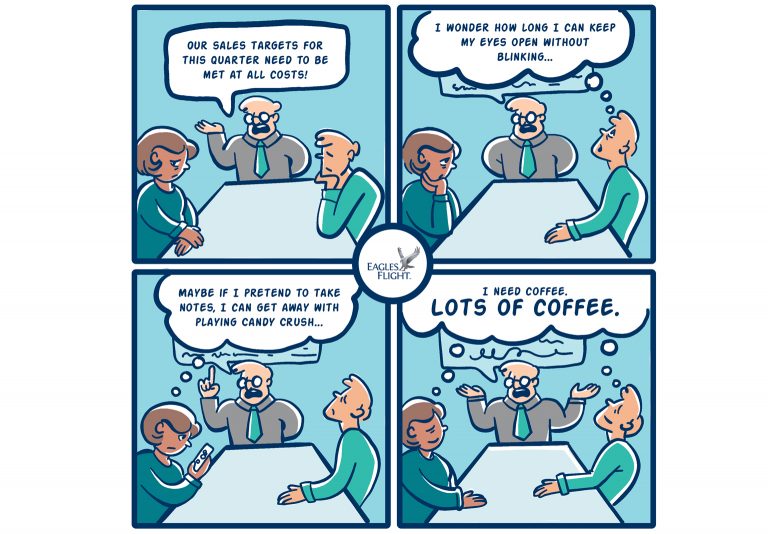- Corporate Culture
- Janina Bernardo
- March 27, 2023
Top 10 Tips for Managing Effective Meetings: Strategies for Busy Managers and Executives

Team meetings are goldmines for comedy. Poking fun at meetings is the subject of countless comic strips and a mainstay in widely popular TV shows like The Office. We often laugh about how horrible and soul-sucking they are.
However, meetings are an inevitable part of our professional lives. They can provide a forum for individuals to come together, share their ideas, and work toward achieving a shared goal. They are a crucial component of effective teamwork, collaboration, and decision-making. Meetings help build trust and a sense of community, but sadly, many meetings waste time and raise stress levels.
By recognizing the value of your team’s time and taking steps to ensure that meetings are productive and purposeful, leaders can foster a positive work environment and drive successful outcomes.
1 – Come Prepared with a Clear Agenda
Always lead a meeting prepared. You need to have a firm grasp of the meeting’s purpose and clearly outline your objectives. Inviting people to contribute ideas for the agenda enhances ownership and involvement. Don’t hold meetings simply out of habit.
2 – Get the Right People Present
Carefully choose the people who need to attend. Logistics will be easier if there are fewer people invited. There is also a risk of low participation for less outspoken members when many people are present.
3 – Celebrate the Wins, Share the Learnings
Discuss and evaluate tangible results and accomplishments from the previous meetings. Everyone benefits from having something to celebrate. At the same time, setbacks and missteps can be framed as learning opportunities.
4 – Share The Vision
Influential leaders know the importance of communication skills in running productive meetings. As a visionary, you should be able to express your ideas clearly and master the art of storytelling to hold your audience’s undivided attention.
It is also crucial to recognize that you are mainly performing a supporting role, even if you do need to provide your thoughts to move discussions forward.
5 – Encourage Open Communication
Give everyone a chance to speak up. Employ active listening and probe for further information. Consider incorporating moments of silence so that individuals may dwell on ideas and form opinions without being influenced by others.
This helps guarantee that everyone involved has a chance to contribute; they feel safe and comfortable raising their hands and leave feeling invested in the results.
6 – Set the Tone
The meeting’s atmosphere will reflect your leadership style. Make everyone feel valued and included by establishing a positive and collaborative environment. Go to the meeting with enthusiasm and show you care about the issues at hand.
7 – Drive Collaboration
Drive home the value of teamwork and cooperation by highlighting the benefits of working together and encouraging individuals to share their expertise and insights. A collaborative team is dependent on working amongst a psychologically safe environment.
8 – Mindset Is Everything
The mindset of your team is vital to success, so start with a motivational message or celebrate recent wins. It is important to recognize the difficulties your team may be experiencing, but keep the conversation focused on potential gains and strategies to overcome them.
9 – Active Participation
Incorporate activities that foster camaraderie and participation. A simple icebreaker at the beginning of the meeting or a team-building activity might do the trick. By promoting active participation throughout, it enables greater ownership as to the outcomes and decisions made in the meeting amongst the team.
10 – Be Decisive
A leader must act decisively and be prepared to make tough decisions. You must take responsibility for the repercussions of your decisions and be accountable for the results. Articulate why certain ideas were favored more than others. You should get your team on board with the decisions made. Everyone at the table should have faith in the leadership and the team. Your goal for a meeting is to inspire the group to act.
Honing your leadership skills can enhance your ability to provide clear direction and focus, engage team members, and build consensus around decisions. At Eagles Flight, we offer practical programs to help your organization develop the skills necessary to thrive in today’s ever-changing workplace. Contact us at efasia.sales@eaglesflight.com for more information on how to bring your leaders and teams to the next level.
